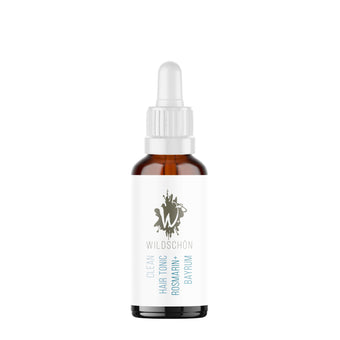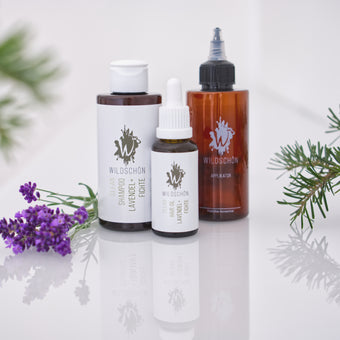What you can do about hair loss, even if you don't know the cause
- How much hair loss is normal?
- What role do hormones play in hair loss?
- What Causes Hair Loss and What Can You Do?
You may have noticed that sometimes you lose less and sometimes more hair. But when is that cause for concern? Now, hair loss is not the same as hair loss. Still, if you notice hair loss, you should take it seriously and talk to your dermatologist. But you can do something for your hair health yourself (also preventively) by paying attention to your diet and enough exercise and avoiding hormonally active ingredients in your cosmetic products.
Losing up to 300 hairs a day is normal
Losing hair is normal because hair has a life cycle too. Without going into the biology now, it's considered normal to lose 70 to 150 hairs a day. But that doesn't mean that you should count all the hair that has fallen out, nor that you have to go to the doctor when you have your 151st hair. Because in certain situations it can be normal that you lose more hair than usual. For example after special stresses, such as washing your hair or a visit to the hairdresser. Then up to 300 hairs can say goodbye a day. It's also common in autumn for more hair to say "goodbye" without us doing much to help. In order to better understand the phenomenon of hair loss, let's take a quick look at how the body communicates.
Hormones control many processes in our body
If something is to be changed in our body, then this must be communicated "internally". Need a short sprint to the train? More energy is needed ad hoc and stress hormones are released. Ate too much sweets? The blood sugar level has to get back on track, insulin is released and so on. This endogenous communication takes place via various hormones. Our brain monitors and controls the hormone levels in the blood to keep things running smoothly. However, the endocrine system is sensitive: if something is wrong here or changes, you will notice physical effects. For example, the physical changes that take place when children become teenagers involve hormonal changes. Perhaps you can now imagine that hormones also play a role in relation to hair and hair loss.
Genetic hair loss due to hypersensitivity
Let's start with one of the most well-known hormones: testosterone. Incidentally, women have this too, although it is generally known as the male hormone. However, testosterone itself is not the culprit in genetic hair loss. The bad guy is called dehydrotestosterone, and it's an intermediate product that's formed in the formation of testosterone. Some people are hypersensitive to this intermediate. This hypersensitivity, in turn, is mostly genetic. In the case of hypersensitivity to dehydrotestosterone, the hair roots shrink and die. In women, the hair then often “only” becomes evenly thinner. In men, on the other hand, it often begins with the so-called receding hairline and develops until the head is completely bald. Unfortunately, there is not much that can be done about this hypersensitivity. If this affects you, a specialist endocrinologist may be able to help you.
Cause unknown: circular hair loss
Circular hair loss is noticed fairly quickly because it usually occurs acutely and suddenly. The exact cause is still unknown. Circular hair loss is often accompanied by (hidden) inflammation. It is therefore assumed that the immune system could play a role here and the body's own defense cells attack (and destroy) the hair roots. When the immune system turns against your own body, it's called autoimmunity. As a result, autoimmune diseases can develop, such as thyroid diseases. Now you might be wondering what this has to do with hormones. As part of our body, our immune system does not work in isolation either, but is connected to our nervous system, namely – you may have guessed it – via hormones. In the case of circular hair loss, the hair often grows back on its own within a year. Since the cause is not known and the hair loss often stops on its own, it is not clear which of the possible forms of treatment works. However, a visit to the doctor is also advisable here.
In the case of diffuse hair loss, the cause is usually more difficult to find
As the word “diffuse” already suggests, the head of hair here is thinning all over the head. The reasons for this can lie in many areas. Here are a few examples:
- in women after childbirth
- due to certain diseases, e.g. B. shingles or erysipelas
- through taking medication, especially through β-blockers, lipid-lowering drugs or cancer drugs (cytostatics)
- due to metabolic disorders such as diabetes mellitus, dyslipidemia or severe liver dysfunction
- Lack of proteins, essential fatty acids and trace elements, especially iron, zinc, folic acid or B12
- through diets that consume less than 1,000 kcal per day
- environmental pollutants (rare, but possible)
- thyroid dysfunction
- mechanical stress on the hair, e.g. B. by frequent ponytails, wearing headgear or if the head rests a lot when you are bedridden
Sometimes this form of hair loss goes away on its own. This can be the case, for example, if the causative medication is stopped or the illness is over. Even after the birth of a child, hair loss stops by itself when the hormonal balance is changed again.
The dose makes the difference: hormonally active ingredients in conventional cosmetics
You might be wondering what all this has to do with cosmetics or shampoo. If you exclude the genetic and the circular hair loss, there is an intersection with some causes of diffuse hair loss: The hormonal balance in the body is disturbed. This can be due to a direct influence, such as thyroid dysfunction or after childbirth. A disturbance of the hormonal balance can also be a consequence, such as malnutrition or metabolic disorders. However, there are also hormonally active substances (endocrine disruptors) that influence the hormonal balance. These are chemicals that act in the body in a similar way to the body's own hormones. Communication in the body is thus disrupted. It's no wonder then that things don't run smoothly anymore.
Limit values provide only limited protection against the influence of homonell active substances in cosmetics
Now you might be wondering how these chemicals get into your body. One way is through the skin. Our skin has a protective barrier to make it a little harder for foreign substances to penetrate. But this protective barrier (natural skin fat) can be weakened, for example by certain surfactants in conventional cosmetic products. Here we explain how you can break the vicious circle and restore your skin's natural ability to regulate itself. If you want to know more about surfactants in shampoos, read our article . Hormonally active chemicals - admittedly that doesn't sound very good. But now we're getting to the bottom of it: These endocrine disruptors are approved as ingredients for cosmetics, as long as certain limit values are not exceeded. Usually they are not acutely toxic, but they are linked to various health problems. These include, for example, diseases of the female genital organs, malformations of genital organs in boys/men, breast cancer, testicular cancer, thyroid cancer or a lower number and quality of sperm. It is now assumed that the use of these substances will be okay if the legally prescribed limit values are observed. In principle, this sounds logical if it only affects one cosmetic product that you use. However, hormonally active ingredients can mutually reinforce each other in their effect. And most people probably use more than one cosmetic product a day. Maybe you can now better imagine that even these small amounts can have an effect on the hormone balance. Especially when you consider that hormonally active chemicals are not only found in cosmetic products. Incidentally, one of the best known and most common representatives from the ranks of hormonally active ingredients are parabens. They are often used in cosmetics as preservatives and you can easily recognize them by the suffix -paraben. Other representatives are, for example, the UV filter ethylhexyl methoxycinnamate (OMC) or bishpenol A (BPA). The latter is already completely forbidden in certain products.
Tips on what to do about hair loss
Perhaps you are now wondering whether there is anything you can do yourself if your hair is suffering. A first good starting point is to ban all cosmetic products with hormonally active ingredients from your life. Because there are alternatives that do not contain such ingredients and lead to the same result. Incidentally, our Wildschön Clean Beauty products are among the alternatives that do "without" and bring out the natural beauty of your hair. But how can you tell whether a cosmetic product contains hormonally active ingredients? There are a few apps (such as CodeCheck) that will help you with this. With them you scan the barcode of the products and get a list of the questionable ingredients with a short explanation. If you look back at the list of possible causes, there is another area that you can influence directly: your diet. In order to prevent deficiency symptoms, it should be balanced and correspond to a sufficient amount of calories. If you suspect a nutrient deficiency, a metabolic disorder or a thyroid disorder, it is best to speak to a doctor you trust. Exercise is another way to influence your head of hair. At first glance, that may sound a bit far-fetched. In fact, sport/exercise has a positive effect on the hair: the movement also improves blood circulation in the scalp. This also increases blood flow to the hair roots, which in turn promotes hair growth because more nutrients and oxygen reach the hair roots. With regard to your styling, you can score points with variety when it comes to hair loss. As nice as a ponytail or a hat is - in the event of hair loss, loose hair that is not tucked under a hat can do no harm.
Conclusion: pay attention to clean products and to yourself.
Unfortunately, there is not much that can be done against genetic hair loss, as it is based on hypersensitivity. The situation is similar with circular hair loss, since the cause is not yet known and in many cases it simply stops by itself. The situation is different with hormonal hair loss. There are many possible causes here, but correspondingly different starting points. And in some areas you can even do something without doing any harm. This includes a balanced diet, exercise, variety in hair styling and not using cosmetic products with hormonally active ingredients. Of course, our Wildschön Clean Beauty products are also “clean” in relation to the latter.









